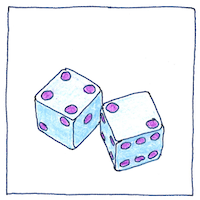Blaise Pascal, Pierre de Fermat
probability

|
Probability theory
Pascal and Fermat corresponded over “the problem of points,” that is, how to fairly divide the stakes of a game if the game were left unfinished. They were the first to realize that fairness depends on the number of possible outcomes left in the game. Fermat drew a tree of all possible outcomes, and counted how many outcomes led to each player winning. Pascal showed how to calculate the number of outcomes and introduced the notion of expected value, the weighted average of all possible outcomes.
Odds
One’s odds are the ratio of the probability of an event happening to the probability of it not happening. You might have a one in five odds of reading this, given that you noticed it at all.
Betting
My advice: Retire early and beat the odds. With a lifetime annuity or traditional retirement plan, the company should end up paying you to live longer; however, the law of large numbers is against you and they are banking on that. Actuarial tables say you will die before you’re eighty-five. Go ahead and defy them, and don’t forget quality is as important as quantity. Defy them; live a long and happy life. You’ll be in trouble only if everyone does it.



This correspondence between Pascal and Fermat influenced Christiaan Huygens, who published the first book on probability theory three years later. Huygens was the guy who first declared that Saturn has a ring, and who invented the pendulum clock.
Fermat was the first to evaluate the integral of general power functions, which influenced both Newton and Leibnitz in their creation of calculus.
See also in The book of science:
Readings in wikipedia: